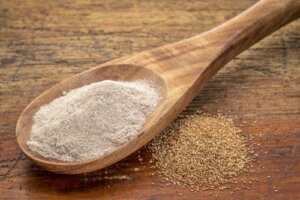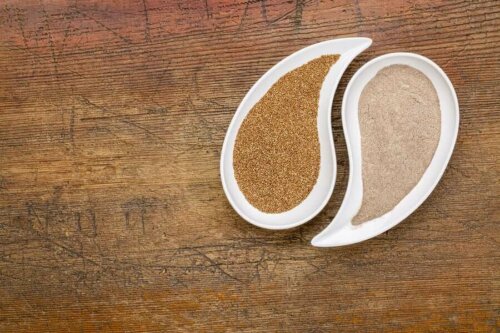Characteristics and Qualities of Teff Flour

How would you like to eat bread and sweets while maintaining a wholesome diet? You may not be aware of it but it’s possible. For instance, you can replace any type of refined flour with whole-grain flour, such as teff flour, in any recipe that calls for it. It’s great for all sorts of recipes for delicious treats. The best part is you don’t have to worry about gaining weight.
Stick around and read more about this product and its characteristics as well as how to use it. Keep in mind that the basis of a well-balanced diet is variety and the adequate distribution of nutrients.
What’s teff flour?
Teff flour comes from a rather small, brown-colored grain from Ethiopia. Its appearance and nutrient content is similar to quinoa and has a sweet toasted aroma. Historians say people have been cultivating it for more than 5000 years.
Ethiopians use it to make the artisan flatbread they use as the base for their dishes. The popularity of this grain has increased due to its properties. Research published in the magazine Food Chemistry describes it in more detail.
You can use it for making bread, muffins, pastries, etc. Another option is to add it as a thickener in vegetable creams, thick stews and eat it as a cereal with milk in order to replace junky industrial cereals.
Also, it’s worth mentioning that its cultivation is environmentally friendly as it grows under diverse climatic conditions — even in dry or waterlogged soils.
In addition, it has a relatively short cultivation time, during which we can obtain a large proportion of food for both humans and animals. Therefore, its environmental impact is low and its production safe and sustainable over time.
You may be interested in Six Properties and Health Benefits of Carob Flour
Nutritional qualities of teff flour

Teff is a great source of quality carbohydrates and proteins of high biological value, as highlighted in a publication in Plant Foods for Human Nutrition. Also, it contains almost all essential amino acids, especially lysine. Furthermore, teff flour has high fiber content and numerous micronutrients.
Given its high nutritional value, teff can help you enrich your diet, especially if you’re vegan and don’t consume dairy products. This is because you can benefit from quality proteins and calcium in adequate proportions. In fact, it’s also suitable for celiacs, as it’s gluten-free.
In addition, its content in iron and calcium of vegetable origin is outstanding, according to research published in Economic Botanic. Thanks to its high content of iron and some vitamins of the B complex, it can help prevent anemia.
In addition, it provides a high proportion of fiber and resistant starch, which can benefit the control of blood sugar. Thus, it helps reduce the risk of diabetes and other complex pathologies.
This whole-grain cereal is so small that its flour includes the germ and the bran. It also contains many health-beneficial compounds such as prebiotics, phytochemicals, and antioxidants. These, according to the cited studies, can help prevent metabolic diseases such as:
- Diabetes mellitus
- Cardiopathies
- Vascular problems
- Overweight and obesity
- Dyslipidemias
- Hypertension
Nutritional value of teff
This is the value for every 3.5 ounces:
- Energy value: 330 kcal
- Carbohydrates: 65.4 g
- Proteins: 13.3 g
- Fiber: 7.9 g
- Fats: 2,1 g
- Saturated: 0.7 mg
- Calcium: 170 mg
- Iron: 5.4 mg
- Potassium: 480 mg
- Vitamin C: 0.2 mg
- Copper: 0.7 g
- Zinc: 4.4 mg
A recipe with teff flour, chocolate, and walnut muffins

Would you like to try a delicious and healthy dessert? Here we’re going to show you a recipe with teff flour so you can have an idea of how to use this cereal. You can enjoy it in your breakfasts as well as in your snacks. However, try to consult a nutritionist before to determine if this type of preparation is suitable for you.
Ingredients
- Teff flour
- Cassava starch
- 4 tbsp of ground flax seed
- 3 tbsp of coconut sugar
- 1 tbsp of ground cinnamon
- 1 tsp of nutmeg
- A pinch of salt and baking soda
- 2 eggs
- 2 grated apples
- Coconut oil
- Coconut milk
- Chopped dark chocolate or chocolate chips
Elaboration
- Firstly, preheat the oven to 350 degrees Fahrenheit
- Mix the flour, starch, sugar, cinnamon, flax, nutmeg, baking soda, and salt in a bowl
- Then, beat the rest of the ingredients in another bowl (except for the dark chocolate and the nuts)
- Also, add the wet ingredients to the dry ones
- Then, beat all the ingredients in the same bowl
- Incorporate the chocolate and the nuts
- Then, fill the molds to 2/3 of their height and bake for 25 minutes
- Finally, take them out of the oven and let them cool down on a rack
Add teff flour to your meals
Have you tried teff flour yet? As you can see, it’s an ingredient that’s full of nutrients and one which you can easily incorporate into your diet. Moreover, it’s ideal for replacing conventional refined flours.
In any case, be moderate in your consumption of carb-rich food. This is because the main function of these nutrients is energetic and your needs for them are lower if your regular physical activity is also low.
All cited sources were thoroughly reviewed by our team to ensure their quality, reliability, currency, and validity. The bibliography of this article was considered reliable and of academic or scientific accuracy.
- Zhu, F. (2018, January 15). Chemical composition and food uses of teff (Eragrostis tef). Food Chemistry. Elsevier Ltd. https://doi.org/10.1016/j.foodchem.2017.06.101
- Shumoy, H., & Raes, K. (2017, December 1). Tef: The Rising Ancient Cereal: What do we know about its Nutritional and Health Benefits? Plant Foods for Human Nutrition. Springer New York LLC. https://doi.org/10.1007/s11130-017-0641-2
- Mengesha MH., Chemical composition of teff (Eragrostis Tef) compared with that of wheat, barley and grain sorghum. Economic botany, 1966.
This text is provided for informational purposes only and does not replace consultation with a professional. If in doubt, consult your specialist.









